Development and Application of an AI-Based Automatic Identification System for Rural Road Distress and Maintenance Management
Abstract
1. Introduction
2. Design of the Automatic Identification System for Rural Road Diseases
2.1. System Architecture Design
2.2. Design of Lightweight Intelligent Inspection Hardware System
3. Automatic Identification Algorithm for Rural Road Pavement Distress
3.1. Typical Types of Rural Road Pavement Distress
3.2. Distress Sample Annotation Method
3.3. Typical Detection and Identification Process of Rural Road Diseases
3.3.1. Establishing a Sample Database of Typical Rural Road Distress
3.3.2. Construction of a Typical Rural Road Disease Identification Algorithm
3.3.3. Recognition Results Under Different Annotation Methods
3.3.4. Comparison of Automatic Distress Recognition Models for Different Pavement Types
4. Application for Rural Road Maintenance and Management
- (1)
- Data validation
- (2)
- Rural road distress database
- (3)
- Maintenance Work Orders
- (4)
- Data Reports
5. Conclusions
Author Contributions
Funding
Data Availability Statement
Conflicts of Interest
References
- Zhu, J.; Wu, Y.; Ma, T. Multi-Object Detection for Daily Road Maintenance Inspection with UAV Based on Improved YOLOv8. IEEE Trans. Intell. Transp. Syst. 2024, 25, 16548–16560. [Google Scholar] [CrossRef]
- Mathew, B.S.; Isaac, K.P. Optimisation of Maintenance Strategy for Rural Road Network Using Genetic Algorithm. Int. J. Pavement Eng. 2014, 15, 352–360. [Google Scholar] [CrossRef]
- Shan, F.; Li, H.; Wang, Z.; Jin, M.; Chen, D. Optimizing Rural Highway Maintenance Scheme with Mathematical Programming. Appl. Sci. 2024, 14, 8253. [Google Scholar] [CrossRef]
- Pasindu, H.; Ranawaka, R.; Sandamal, R.; Dias, T. Incorporating Road Safety into Rural Road Network Pavement Management. Int. J. Pavement Eng. 2021, 23, 4306–4319. [Google Scholar] [CrossRef]
- Yang, G.; Wang, H.; Pan, Y.; Li, L. Research on Application of the Rural Road Performance Assessment Method in Jiangsu Province. Road Mater. Pavement Des. 2017, 18 (Suppl. 3), 76–87. [Google Scholar] [CrossRef]
- Hu, Y.; Chen, N.; Hou, Y.; Lin, X.; Jing, B.; Liu, P. Lightweight Deep Learning for Real-Time Road Distress Detection on Mobile Devices. Nat. Commun. 2025, 16, 4212. [Google Scholar] [CrossRef] [PubMed]
- Hui, L.; Ibrahim, A.; Hindi, R. Computer Vision-Based Concrete Crack Identification Using MobileNetV2 Neural Network and Adaptive Thresholding. Infrastructures 2025, 10, 42. [Google Scholar] [CrossRef]
- Li, J.; Li, X.; Liu, K.; Yao, Z. Crack Identification for Bridge Structures Using an Unmanned Aerial Vehicle (UAV) Incorporating Image Geometric Correction. Buildings 2022, 12, 1869. [Google Scholar] [CrossRef]
- An, H.; Fan, Y.; Jiao, Z.; Liu, M. Research on Improved Bridge Surface Disease Detection Algorithm Based on YOLOv7-Tiny-DBB. Appl. Sci. 2025, 15, 3626. [Google Scholar] [CrossRef]
- Sheng, B.; Wu, L.; Zhang, N. A Maturity Detection Method for Hemerocallis Citrina Baroni Based on Lightweight and Attention Mechanism. Appl. Sci. 2023, 13, 12043. [Google Scholar] [CrossRef]
- Jiang, M.; Gielen, G.; Deng, B.; Zhu, X. A Fast Learning Algorithm for Time-Delay Neural Networks. Inf. Sci. 2002, 148, 27–39. [Google Scholar] [CrossRef]
- Kim, J.Y. Development of New Automated Crack Measurement Algorithm Using Laser Images of Pavement Surface. Master’s Thesis, The University of Iowa, Iowa City, IA, USA, 2008. [Google Scholar]
- Wang, K.C.P.; Gong, W.-G. Real-Time Automated Survey System of Pavement Cracking in Parallel Environment. J. Infrastruct. Syst. 2005, 11, 154–164. [Google Scholar] [CrossRef]
- Redmon, J.; Farhadi, A. YOLOv3: An Incremental Improvement. arXiv 2018. [Google Scholar] [CrossRef]
- Ren, S.; He, K.; Girshick, R.; Sun, J. Faster R-CNN: Towards Real-Time Object Detection with Region Proposal Networks. IEEE Trans. Pattern Anal. Mach. Intell. 2017, 39, 1137–1149. [Google Scholar] [CrossRef] [PubMed]


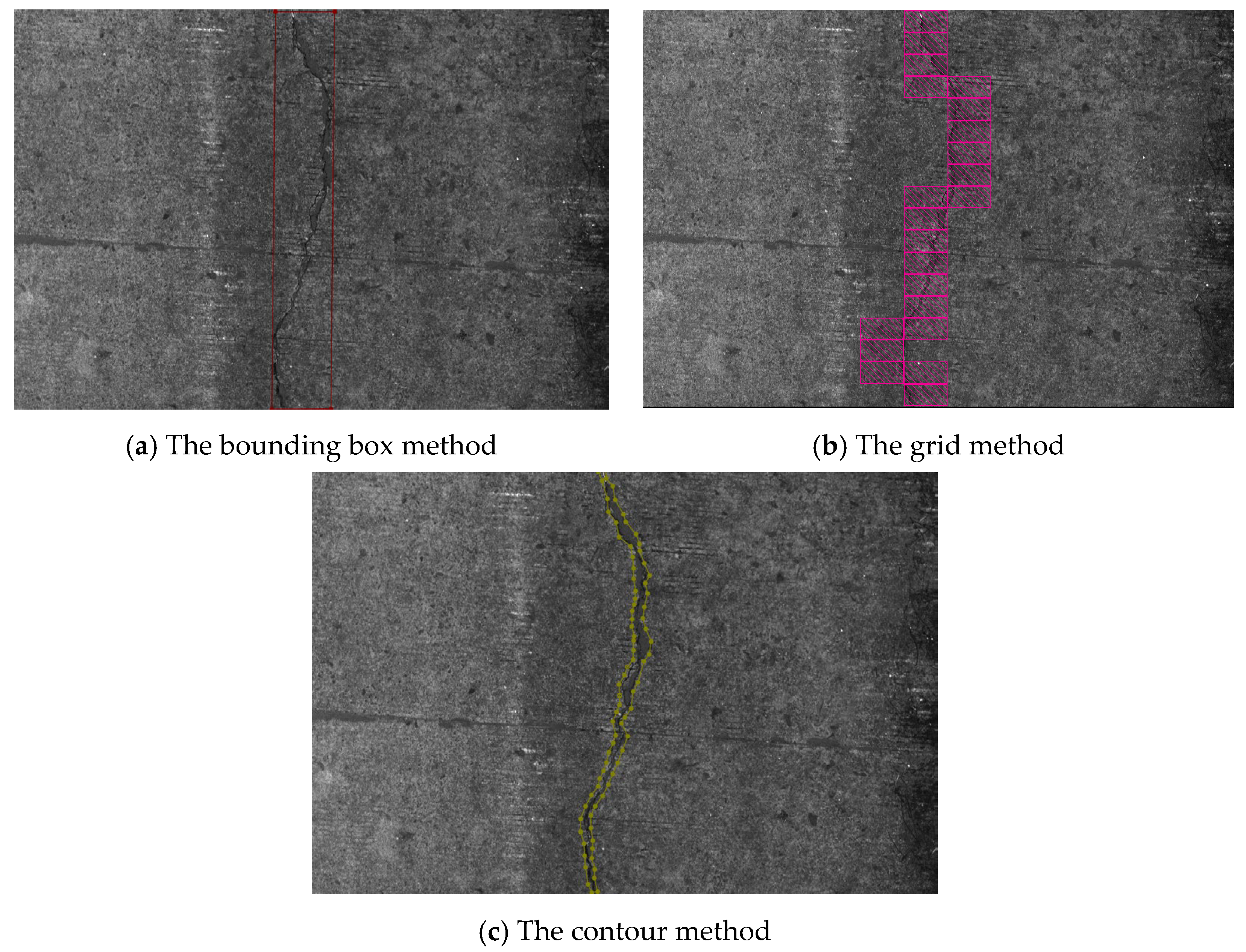
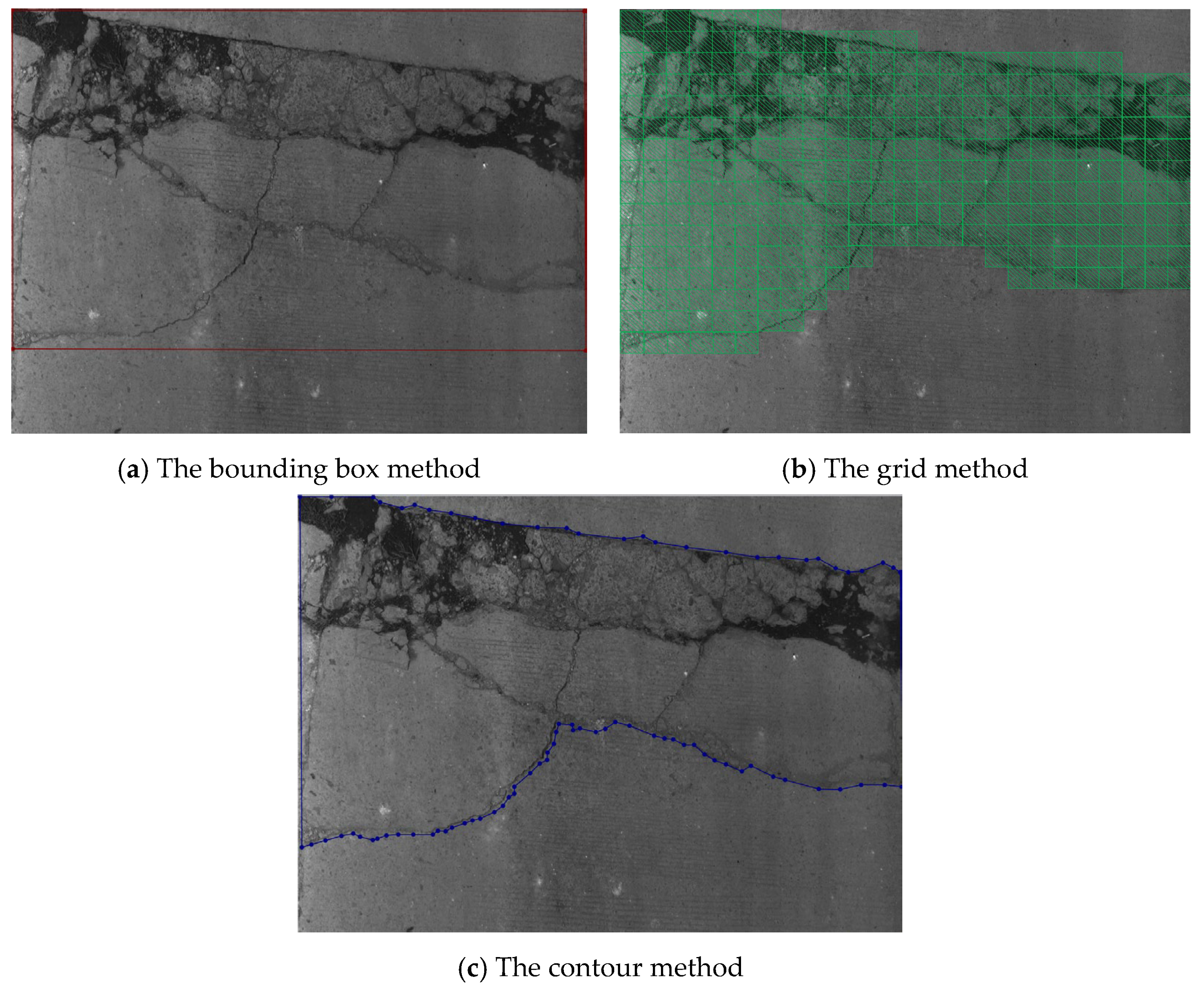


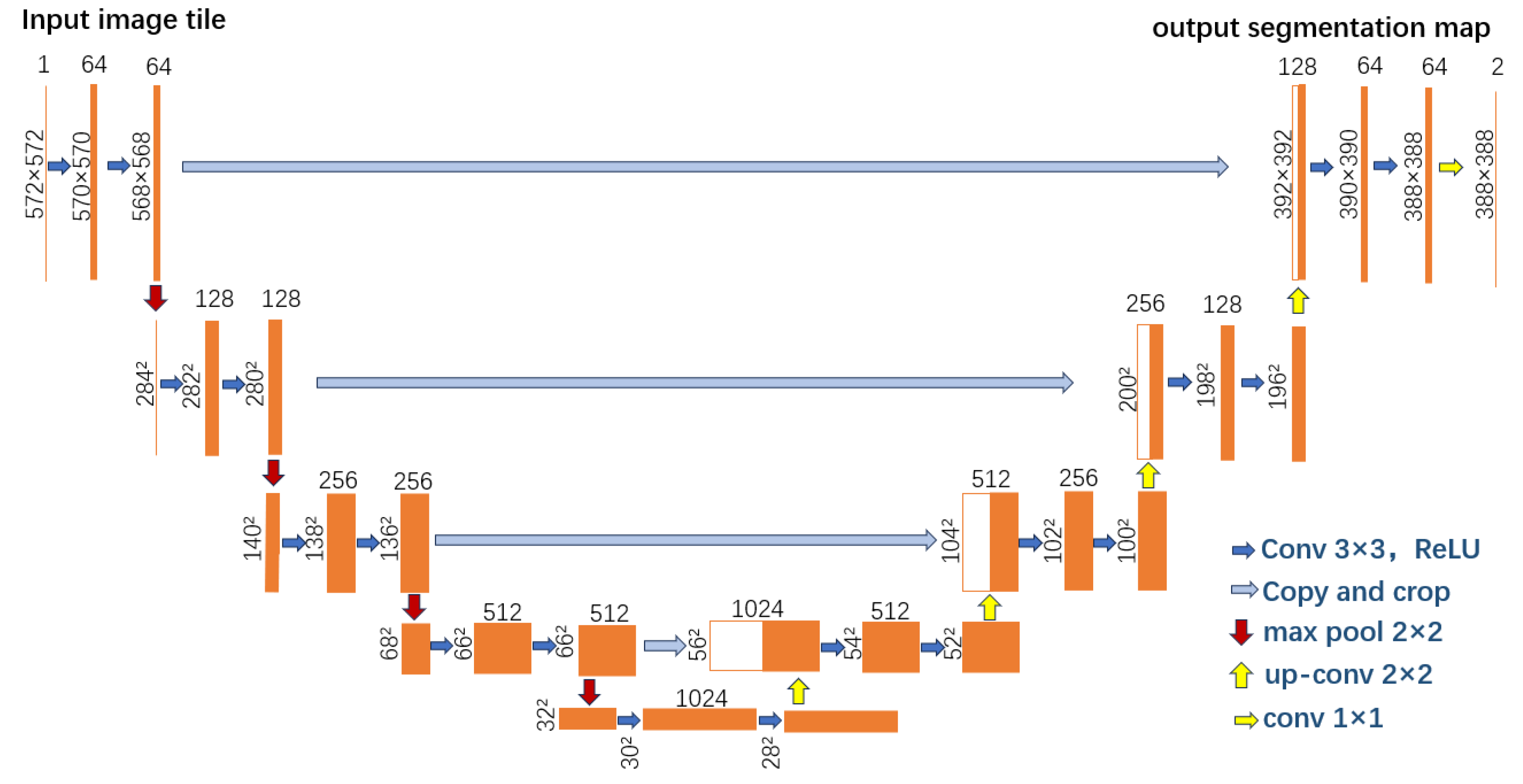

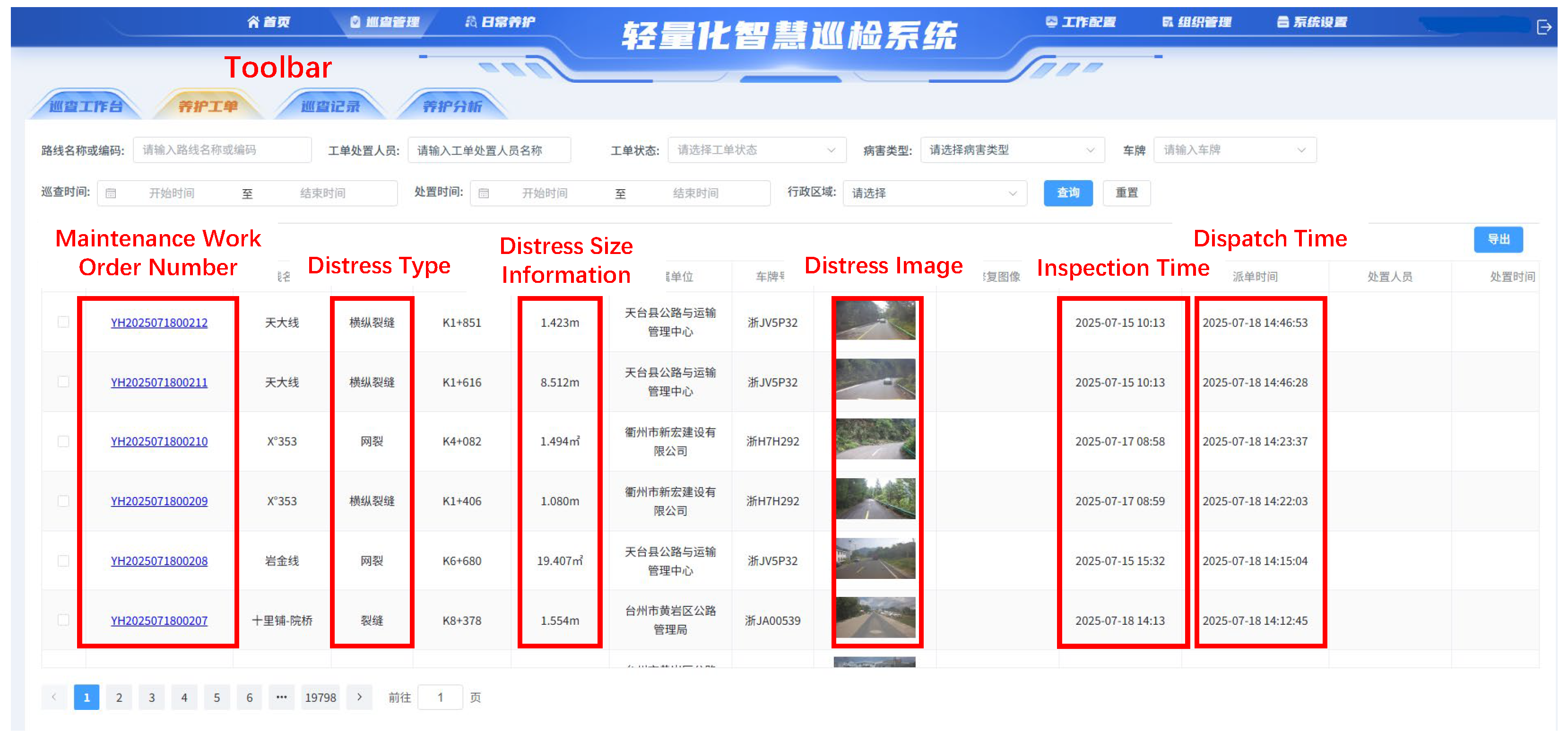

| Item | Description |
|---|---|
| CPU | 11th Gen Inter(R) Core(TM) I5-1135G7@2.49GHZ |
| RAM/ROM | 8 GB-DDR3L 1600 MHz |
| Operation System | Windows 11 Professional Edition 22H2 |
| Hard Drive | Samsung SSD 870 EVO 500GB |
| Ethernet Port | 4× Intel® i211 Gigabit Ethernet Ports; supports PoE (Power over Ethernet); compliant with IEEE 802.3af; supports Wake-on-LAN/PXE boot |
| COM Port | 4× RS232/RS485, switchable via jumper caps; COM1–COM4 support digital capacitive isolation |
| Wireless Communication | 1× External SIM card slot connected to M.2 B-key slot, supports 4G/5G wireless networking |
| GPS | GPS + BDS + SBAS + QZSS hybrid positioning with <2 m positioning error and <0.1 m/s velocity error; output frequency: 10 Hz |
| Camera | Triangular magnetic base; 2560 × 1440 resolution; autofocus; strong light suppression; backlight enhancement; Frame rate: 50 Hz, 25 fps |
| Power Connection | Connects to vehicle power supply |
| Power Supply Voltage | 24 V, 5 A |
| Operating Temperature | −20 to +70 °C |
| Waterproof Rating | IP67-rated waterproof |
| Antenna Type | 4× High-gain magnetic metal rod antennas |
| Antenna Height | 230 mm ± 3 mm |
| Device Installation Method | The GPS module and camera are magnetically mounted; the industrial computer is fixed in an enclosed housing |
| Annotated Images | Type | Feature |
|---|---|---|
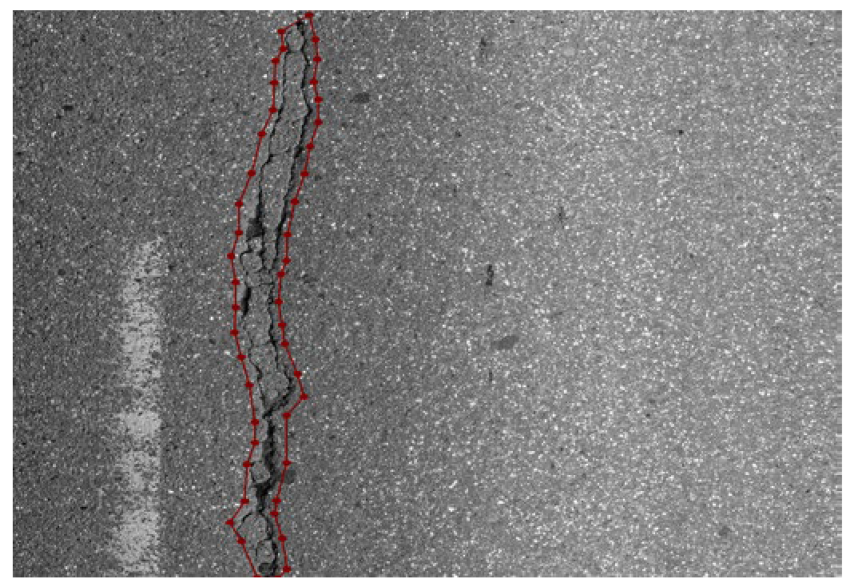 | Longitudinal cracks in asphalt pavements | The cracks are generally parallel to the driving direction, with the angle α1 clearly falling between 45° and 90°. The annotation even includes fine cracks, with markings along the outer edge of the crack. |
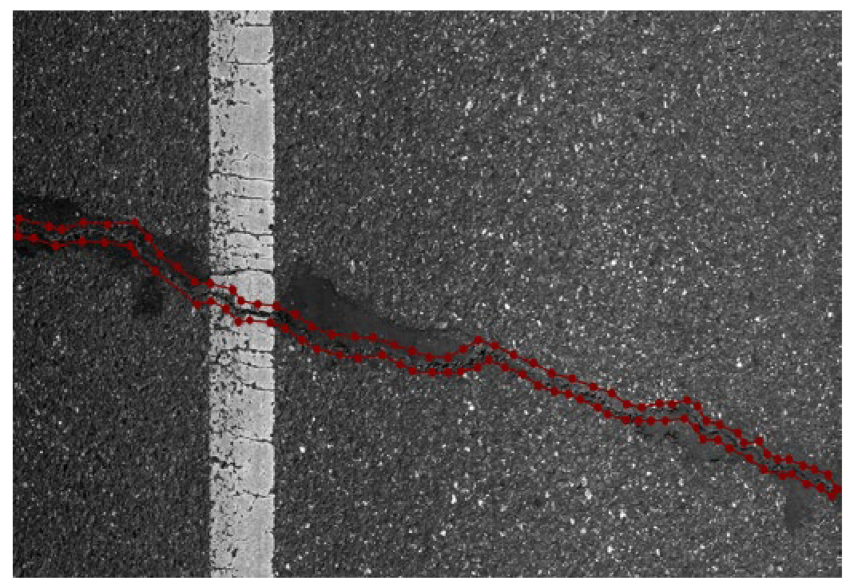 | Transverse cracks in asphalt pavements | The cracks are generally perpendicular to the driving direction, with the angle α1 clearly falling between 0° and 45°. If the crack is within a strip repair area, the boundary between the repair and the crack should be identified. Markings are made along the outer edge of the crack. |
 | Alligator cracking in asphalt pavements | Alligator cracking on asphalt pavement shall be defined as a grid-shaped pattern formed by intersecting longitudinal and transverse cracks. Annotations must capture the fine internal cracking within the network, with delineation traced along the outermost boundary of the cracking zone. |
 | Pothole in asphalt pavements | Potholes are localized surface depressions resulting from the disintegration and loss of aggregate in asphalt pavement. Markings should be made along the outer edge of the pothole. |
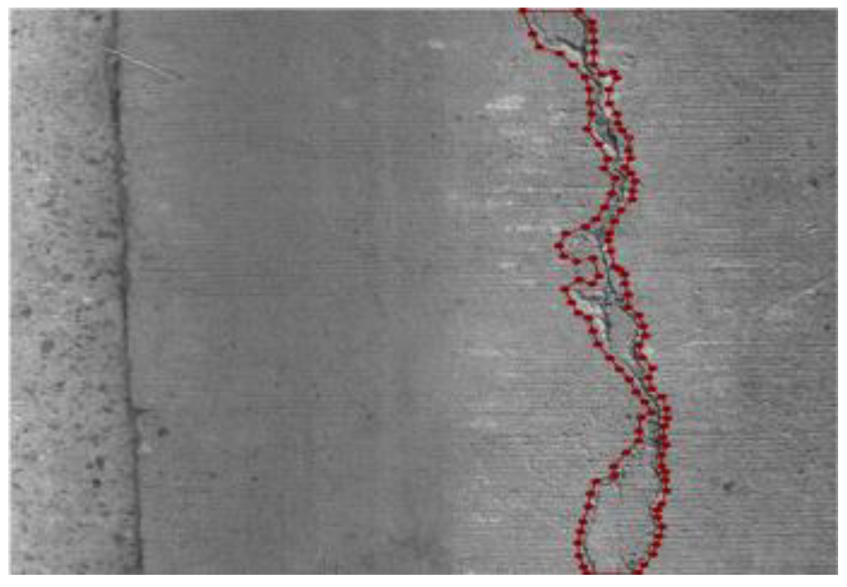 | Cracks in concrete pavements | The cracks are longitudinal, transverse, or diagonal cracks on the cement pavements. The annotation should include fine cracks, marked along the outer edge of the crack. |
 | Broken Slab in concrete pavements | The fractured slab refers to the cement pavement slab with through cracks penetrating the surface layer, and the slab is divided into three or more pieces by the cracks. The annotation should include fine cracks within the range of the through cracks, marked along the outer edge of the fractured slab. |
 | Pothole in concrete pavements | Potholes refer to localized depressions or damage on the cement pavement. The annotation should determine whether the potholes are independent. Independent potholes should be marked along their outer edges separately. |
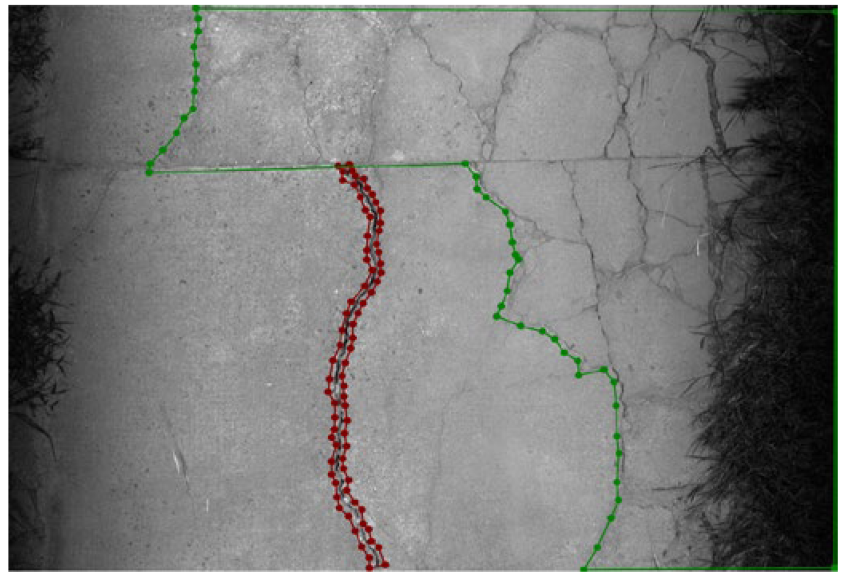 | Combined pavement distresses 1 | If independent cracks outside the fractured slab area are observed in the pavement image, they should be annotated according to the type of defect. When other defects appear within the fractured slab, only the fractured slab should be marked. |
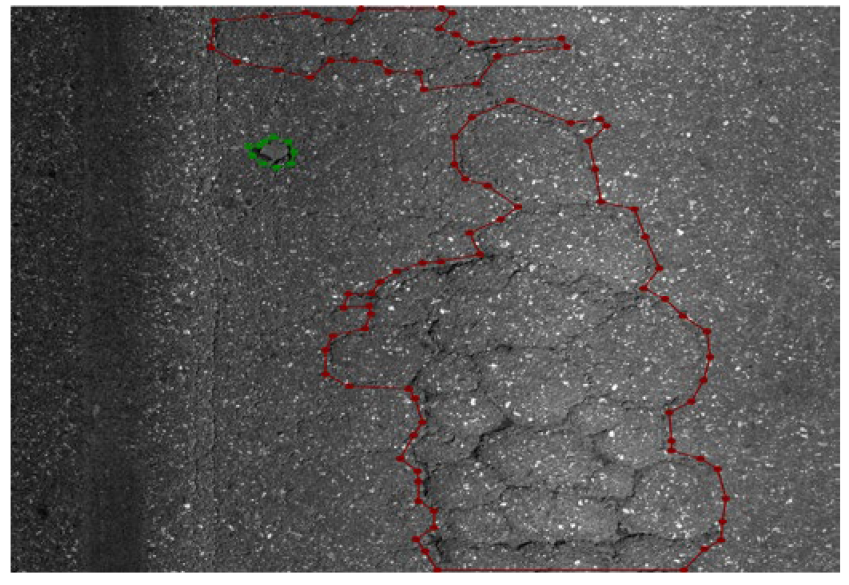 | Combined pavement distresses 2 | If independent potholes outside the extent of the alligator cracking are observed in the pavement image, they should be annotated according to the type of defect. When other defects appear within the alligator cracking area, only the alligator cracking should be marked. |
| Experimental Parameters | Content |
|---|---|
| Dataset Proportion | Training:Validation = 8:2 |
| Model Parameters | Batch Size: 8, Learning Rate: 0.0001, Optimizer: SGD, Number of Epochs: 100, Loss Function: CrossEntropyLoss |
| Annotation Method | Road Type | Distress Type | Sample Images | Accuracy | False Detection | Missed Detection | Accuracy (%) | False Detection Rate (%) | Missed Detection Rate (%) |
|---|---|---|---|---|---|---|---|---|---|
| Bounding box method | Asphalt pavement | Longitudinal cracks | 4000 | 3792 | 123 | 85 | 94.79% | 4.07% | 2.87% |
| Transverse cracks | 4000 | 3780 | 122 | 99 | 94.49% | 5.12% | 4.20% | ||
| Alligator cracking | 3000 | 2847 | 138 | 15 | 94.89% | 9.52% | 1.16% | ||
| Potholes | 3000 | 2710 | 233 | 58 | 90.32% | 10.65% | 2.87% | ||
| Concrete pavements | Cracks | 8000 | 7694 | 223 | 83 | 96.18% | 4.26% | 1.64% | |
| Broken Slab | 3000 | 2827 | 125 | 48 | 94.23% | 10.05% | 4.07% | ||
| Potholes | 3000 | 2836 | 51 | 112 | 94.55% | 3.39% | 7.14% | ||
| Average | 94.20% | 6.72% | 3.42% | ||||||
| Grid method | Asphalt pavement | Longitudinal cracks | 4000 | 3809 | 113 | 78 | 95.22% | 3.75% | 2.61% |
| Transverse cracks | 4000 | 3790 | 116 | 94 | 94.75% | 4.89% | 3.97% | ||
| Alligator cracking | 3000 | 2859 | 130 | 12 | 95.29% | 8.93% | 0.87% | ||
| Potholes | 3000 | 2726 | 224 | 50 | 90.86% | 10.23% | 2.50% | ||
| Concrete pavements | Cracks | 8000 | 7704 | 216 | 80 | 96.30% | 4.14% | 1.57% | |
| Broken Slab | 3000 | 2841 | 118 | 41 | 94.69% | 9.45% | 3.53% | ||
| Potholes | 3000 | 2851 | 43 | 106 | 95.04% | 2.84% | 6.72% | ||
| Average | 94.59% | 6.32% | 3.11% | ||||||
| Contour method | Asphalt pavement | Longitudinal cracks | 4000 | 3821 | 107 | 72 | 95.53% | 3.53% | 2.40% |
| Transverse cracks | 4000 | 3804 | 110 | 86 | 95.10% | 4.60% | 3.63% | ||
| Alligator cracking | 3000 | 2869 | 124 | 7 | 95.63% | 8.50% | 0.52% | ||
| Potholes | 3000 | 2741 | 216 | 43 | 91.37% | 9.85% | 2.13% | ||
| Concrete pavements | Cracks | 8000 | 7713 | 211 | 76 | 96.41% | 4.03% | 1.49% | |
| Broken Slab | 3000 | 2853 | 109 | 38 | 95.10% | 8.67% | 3.20% | ||
| Potholes | 3000 | 2866 | 36 | 98 | 95.53% | 2.36% | 6.18% | ||
| Average | 94.95% | 5.93% | 2.79% | ||||||
| Road Type | Distress Type | Defect Identification Example Image 1 | Defect Identification Example Image 2 |
|---|---|---|---|
| Asphalt pavements | Longitudinal cracks | 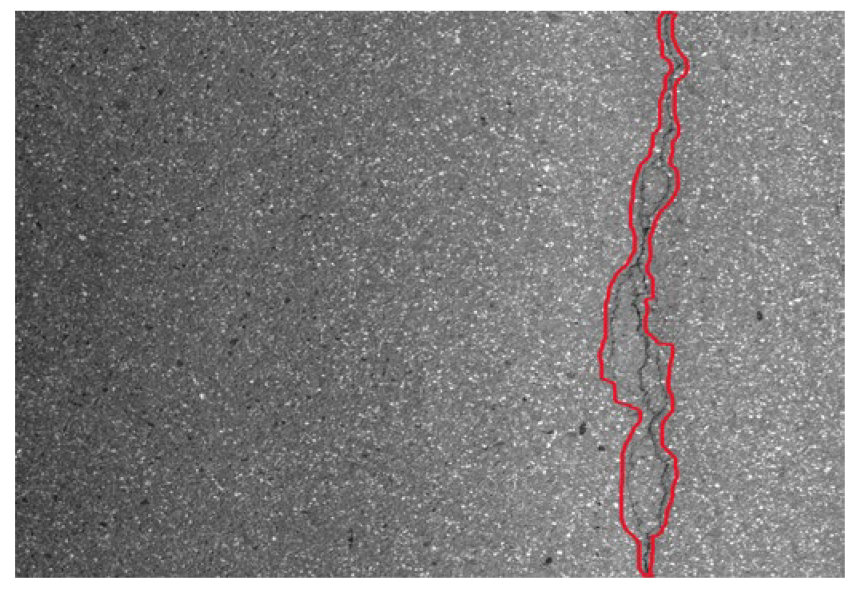 |  |
| Transverse cracks | 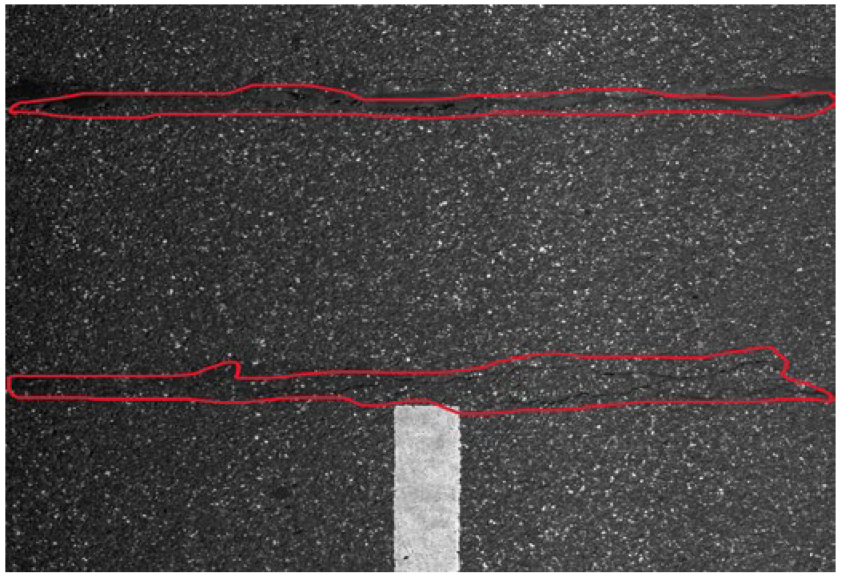 |  | |
| Alligator cracking | 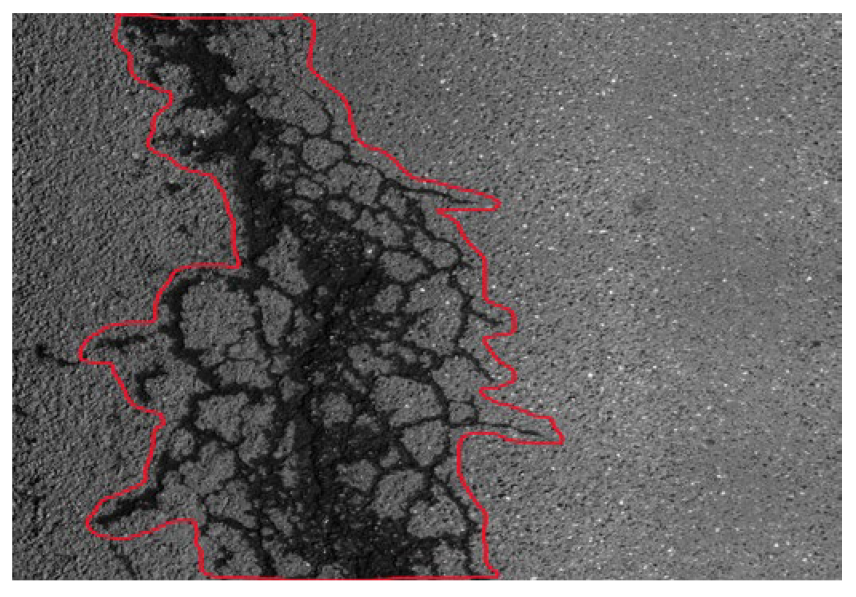 |  | |
| Potholes | 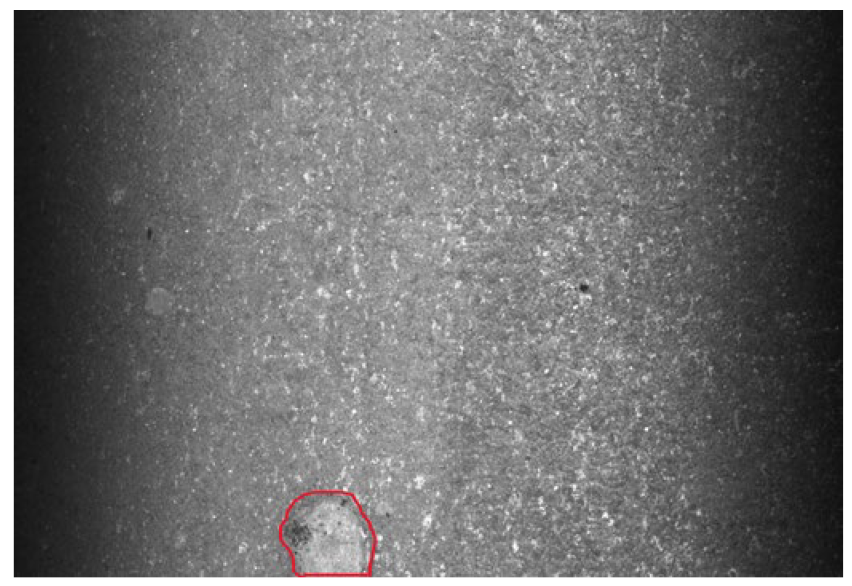 |  | |
| Concrete pavements | Cracks |  | 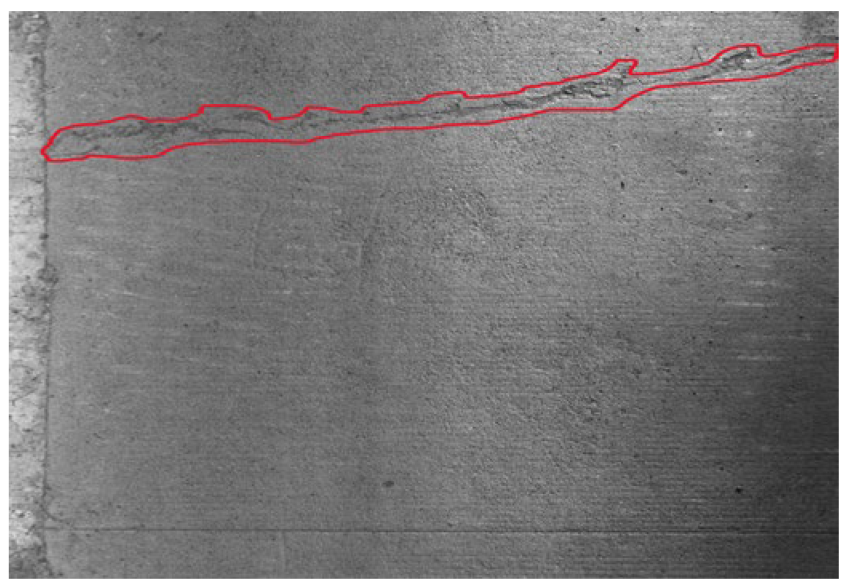 |
| Broken Slab |  | 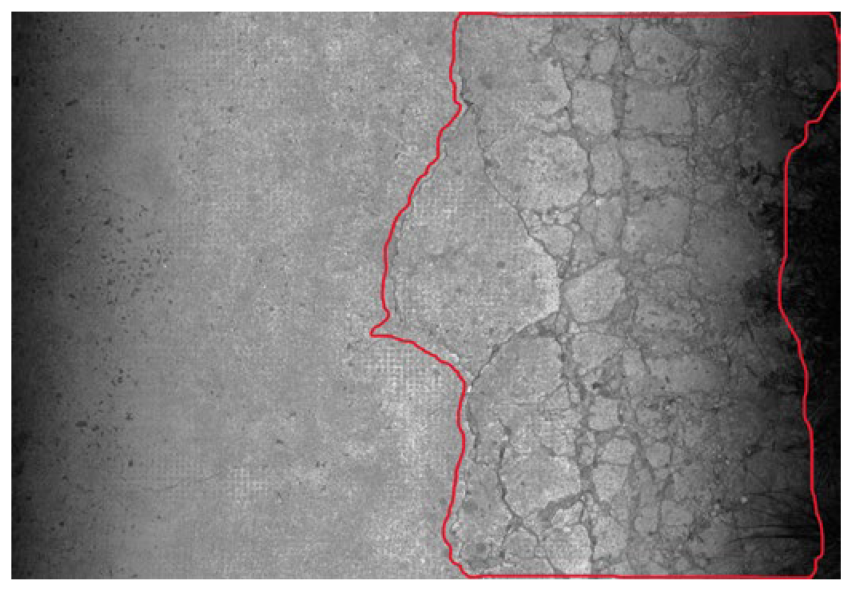 | |
| Potholes | 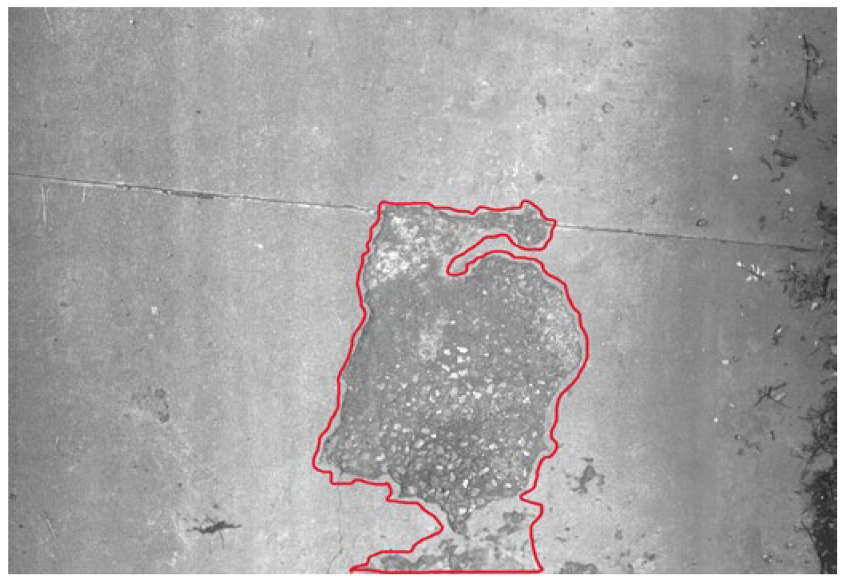 |  |
| Model | Evaluation Metrics | ||
|---|---|---|---|
| Accuracy Rate | False Detection Rate | Missed Detection Rate | |
| YOLO v3 | 90.36% | 6.74% | 2.9% |
| Fastr R-CNN | 93.86% | 4.74% | 1.4% |
| Unet | 95.04% | 3.67% | 1.29% |
Disclaimer/Publisher’s Note: The statements, opinions and data contained in all publications are solely those of the individual author(s) and contributor(s) and not of MDPI and/or the editor(s). MDPI and/or the editor(s) disclaim responsibility for any injury to people or property resulting from any ideas, methods, instructions or products referred to in the content. |
© 2025 by the authors. Licensee MDPI, Basel, Switzerland. This article is an open access article distributed under the terms and conditions of the Creative Commons Attribution (CC BY) license (https://creativecommons.org/licenses/by/4.0/).
Share and Cite
Chen, L.; Zhang, H.; Li, D.; Li, Y.; Lou, J.; Fu, K. Development and Application of an AI-Based Automatic Identification System for Rural Road Distress and Maintenance Management. Buildings 2025, 15, 4222. https://doi.org/10.3390/buildings15234222
Chen L, Zhang H, Li D, Li Y, Lou J, Fu K. Development and Application of an AI-Based Automatic Identification System for Rural Road Distress and Maintenance Management. Buildings. 2025; 15(23):4222. https://doi.org/10.3390/buildings15234222
Chicago/Turabian StyleChen, Longjin, Hang Zhang, Dongfang Li, Yulong Li, Jiang Lou, and Kenxuan Fu. 2025. "Development and Application of an AI-Based Automatic Identification System for Rural Road Distress and Maintenance Management" Buildings 15, no. 23: 4222. https://doi.org/10.3390/buildings15234222
APA StyleChen, L., Zhang, H., Li, D., Li, Y., Lou, J., & Fu, K. (2025). Development and Application of an AI-Based Automatic Identification System for Rural Road Distress and Maintenance Management. Buildings, 15(23), 4222. https://doi.org/10.3390/buildings15234222






